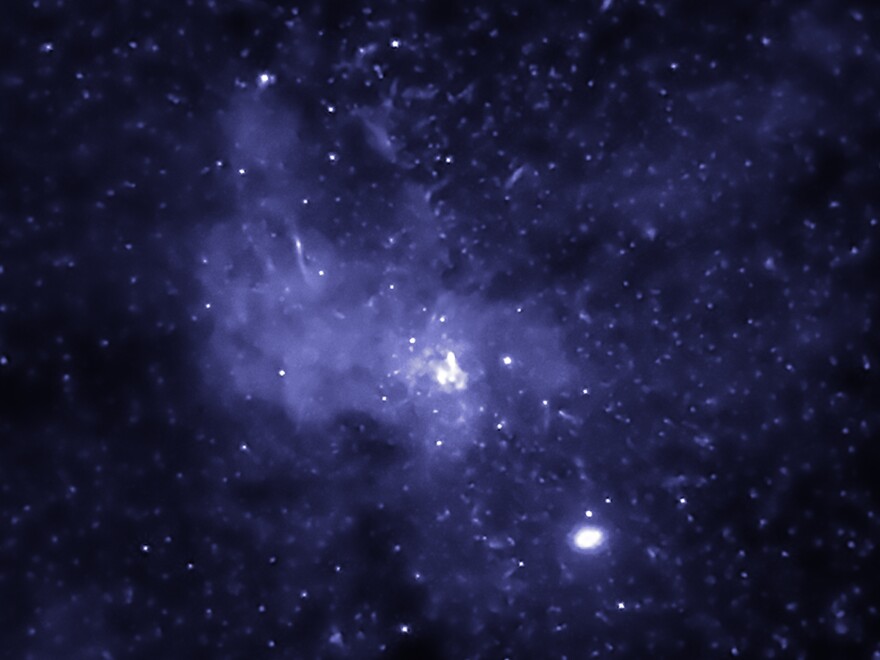With our free press under threat and federal funding for public media gone, your support matters more than ever. Help keep the LAist newsroom strong, become a monthly member or increase your support today .
What Does A Black Hole Sound Like? NASA Has An Answer

For the first time in history, earthlings can hear what a black hole sounds like: a low-pitched groaning, as if a very creaky heavy door was being opened again and again.
NASA released a 35-second audio clip of the sound earlier this month using electromagnetic data picked from the Perseus Galaxy Cluster, some 240 million light-years away.
The data had been sitting around since it was gathered nearly 20 years ago by the Chandra X-Ray Observatory. The decision to turn it into sound came only recently, as part of NASA's effort over the past two years to translate its stunning space photography into something that could be appreciated by the ear.
"I started out the first 10 years of my career really paying attention to only the visual, and just realized that I had done a complete disservice to people who were either not visual learners or for people who are blind or low-vision," NASA visual scientist Kimberly Arcand told NPR in an interview with Weekend Edition.
While the Perseus audio tries to replicate what a black hole actually sounds like, Arcand's other "sonifications" are more or less creative renditions of images. In those imaginative interpretations, each type of material — gaseous cloud or star — gets a different sound; elements near the top of images sound higher in tone; brighter spots are louder.
For more examples of NASA's sonifications, go to the agency's Universe of Sound web page. Or read on to learn more from Arcand about the venture.
Interview Highlights
On how the black hole audio was made
What we're listening to is essentially a re-sonification, so a data sonification of an actual sound wave in this cluster of galaxies where there is this supermassive black hole at the core that's sort of burping and sending out all of these waves, if you will. And the scientists who originally studied the data were able to find out what the note is. And it was essentially a B-flat about 57 octaves below middle C. So we've taken that sound that the universe was singing and then just brought it back up into the range of human hearing — because we certainly can't hear 57 octaves below middle C.
On sonifying an image of the center of the Milky Way Galaxy
So, we actually take the data and we extrapolate the information that we need. We really pay attention to the scientific story to make sure that conversion from light into sound is something that will make sense for people, particularly for people who are blind or low vision. So our Milky Way galaxy — that inner region — that is this really sort of energetic area where there's just a whole lot of frenetic activity taking place. But if we're looking at a different galaxy that perhaps is a little bit more calm, a little bit more restive at its core it could sound completely different.
On the sonification of the "Pillars of Creation" photograph from the Eagle Nebula in the Serpens constellation:
This is like a baby stellar nursery. These tall columns of gas and dust where stars are forming and you're listening to the interplay between the X-ray information and the optical information and it's really trying to give you a bit of the text.
These soundscapes that are being created can really bring a bit of emotion to data that could seem pretty esoteric and abstract otherwise.
-
Copyright 2024 NPR. To see more, visit npr.org.
At LAist, we believe in journalism without censorship and the right of a free press to speak truth to those in power. Our hard-hitting watchdog reporting on local government, climate, and the ongoing housing and homelessness crisis is trustworthy, independent and freely accessible to everyone thanks to the support of readers like you.
But the game has changed: Congress voted to eliminate funding for public media across the country. Here at LAist that means a loss of $1.7 million in our budget every year. We want to assure you that despite growing threats to free press and free speech, LAist will remain a voice you know and trust. Speaking frankly, the amount of reader support we receive will help determine how strong of a newsroom we are going forward to cover the important news in our community.
We’re asking you to stand up for independent reporting that will not be silenced. With more individuals like you supporting this public service, we can continue to provide essential coverage for Southern Californians that you can’t find anywhere else. Become a monthly member today to help sustain this mission.
Thank you for your generous support and belief in the value of independent news.

-
The historic properties have been sitting vacant for decades and were put on the market as-is, with prices ranging from $750,000 to $1.75 million.
-
Users of the century old Long Beach wooden boardwalk give these suggestions to safely enjoy it.
-
The Newport Beach City Council approved a new artificial surf park that will replace part of an aging golf course.
-
The utility, whose equipment is believed to have sparked the Eaton Fire, says payouts could come as quickly as four months after people submit a claim. But accepting the money means you'll have to forego any lawsuits.
-
The City Council will vote Tuesday on a proposal to study raising the pay for construction workers on apartments with at least 10 units and up to 85 feet high.
-
The study found recipients spent nearly all the money on basic needs like food and transportation, not drugs or alcohol.







